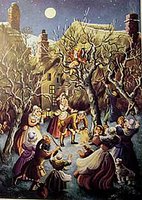 As a kid, I always delighted in the opening of that Kirby vacuum cleaner box filled with ornaments from years past. My siblings and I each had our favorite ones to hang, and we fought over other shared favorites. We took turns every year putting up the topper, which seemed to be the one ornament that only lasted a few years before being replaced.
As a kid, I always delighted in the opening of that Kirby vacuum cleaner box filled with ornaments from years past. My siblings and I each had our favorite ones to hang, and we fought over other shared favorites. We took turns every year putting up the topper, which seemed to be the one ornament that only lasted a few years before being replaced. After I decided to ditch Christmas in 1999, I began to delve into the history of this season's history. Why, for instance, do we decorate evergreens every year? Well, the roots are solely pagan, yet another reason I cringe when I hear the newer slogan, "Put Christ back in Christmas," an issue I will address later in my Solstice Series.
The answer to why we trim trees is an amalgamation of Northern customs.
There is the most well-known Nordic custom of Yule. During Yule, families would seek out the biggest log to decorate with items like mistletoe, holly, and personal effects. Once placed in the hearth and lit, friends and families would party until the log was completely burnt to ash. The revelry was believed to help ensure the return of a sun that seemed to threaten a completely disappearance from the sky.
 Then there is the less well-known English custom of Apple Wassailing. Although most people are familiar with the word "Wassail" through the production of seasonal beers, the actual tradition has slipped into obscurity. On the day of Apple Wassailing, loads of dishes were prepared. During the heat of baking, the man of the house would storm in from the cold, throw whatever the woman of the house was making (breads, dumplings, pies), and march everyone in the house out to the apple orchard. Once there, the family would choose one tree to decorate, which they believed would ensure a bountiful harvest the next fall.
Then there is the less well-known English custom of Apple Wassailing. Although most people are familiar with the word "Wassail" through the production of seasonal beers, the actual tradition has slipped into obscurity. On the day of Apple Wassailing, loads of dishes were prepared. During the heat of baking, the man of the house would storm in from the cold, throw whatever the woman of the house was making (breads, dumplings, pies), and march everyone in the house out to the apple orchard. Once there, the family would choose one tree to decorate, which they believed would ensure a bountiful harvest the next fall. Of course, these two customs represent only two of the possible origins of decorating Christmas trees, and the actual point at which these traditions merged into our current day practice is unknown. Evergreens seem to have been chosen once Christianity began to latch onto the pagan custom because it best represented the immortality of God's only begotten Son.
 Then there's the way these pines are erected before trimming. Today, we prop them upright as we would encounter them in the forest. Not so long ago, less than two hundred years ago, one would be hard pressed to find a home that displayed their trees in such a fashion. Until the 1850s, tradition dictated that the christmas cheer be hung upside down. No one knows for sure what signalled the change in position. Some speculate it was the expansive New World's influence. Afforded larger homes, Americans could keep their trees upright as they had bigger living areas than the average family home in Europe, where space had become a commodity.
Then there's the way these pines are erected before trimming. Today, we prop them upright as we would encounter them in the forest. Not so long ago, less than two hundred years ago, one would be hard pressed to find a home that displayed their trees in such a fashion. Until the 1850s, tradition dictated that the christmas cheer be hung upside down. No one knows for sure what signalled the change in position. Some speculate it was the expansive New World's influence. Afforded larger homes, Americans could keep their trees upright as they had bigger living areas than the average family home in Europe, where space had become a commodity. The year after giving up Christmas, we chose to celebrate Solstice. We made a Yule log and hung our "Solstice" tree upside in the corner. The effect was stunning, a shining top strung from the corner ceiling of our living room. Once hung, we instantly saw the appeal of such posture: space economics. That whole furniture shuffle didn't happen, and little crawling babies couldn't knock down ornaments or the tree itself. More presents fit under the tree with greater ease, thereby freeing up more floor space. Of course, we did get leers from our pre-dominantly Christian neighbors, one of whom asked if we planned on putting an upside-down cross in the front yard while we were at it. Instead of questioning how she figured the two were related, I asked her why she put hers up the way she did. Her answer: "Because that's how you're supposed to do it." Says who?
The important thing to ponder this holiday season is why you decorate a pine tree. Is it because that's what you do at this time of year? Also consider if this makes you a follower or a leader? I'm not implying that if you put up a tree that you're a follower, rather that if you haven't questioned your actions, you just may be one. As that famous Greek Philosopher said, "The unexamined life isn't worth living."



2 comments:
Thank you for the great history lesson; I have learned much.
Now I want to hang our tree upside down next year; Amanda isn't convinced, though. ;-)
Fantastic post!
I didn't know about the Wassailing tradition, or the upside down tree idea. I like your answer to your neighbor.
My favorite thing about Christmas is the tradition of generosity. The Christmas tree is a symbol of that because people place their gifts to one another around it. In my family of choice, even during years when we choose to give to charity rather than exchanging gifts, we always give one another an ornament for the tree. Every year when it's time to decorate again, it's fun to open the ornament box and recollect all the years we've been together.
Post a Comment